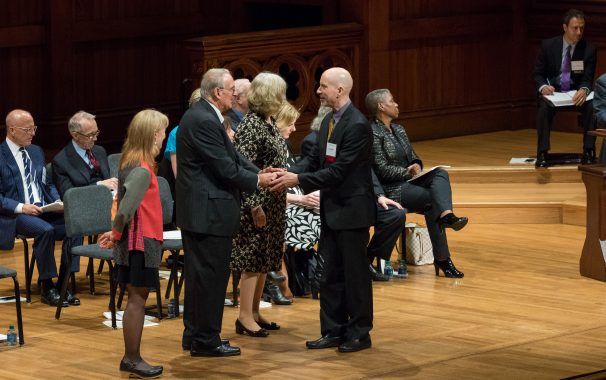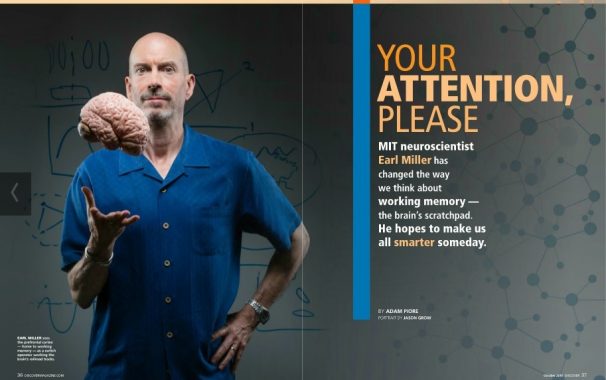Intrinsic neuronal dynamics predict distinct functional roles during working memory
Dante Francisco Wasmuht, Eelke Spaak, Timothy J. Buschman, Earl K. Miller, Mark G. Stokes
doi: https://doi.org/10.1101/233171
Abstract
Working memory (WM) is characterized by the ability to maintain stable representations over time; however, neural activity associated with WM maintenance can be highly dynamic. We explore whether complex population coding dynamics during WM relate to the intrinsic temporal properties of single neurons in lateral prefrontal cortex (lPFC), the frontal eye fields (FEF) and lateral intraparietal cortex (LIP) of two monkeys (Macaca mulatta). We found that cells with short timescales carried memory information relatively early during memory encoding in lPFC; whereas long timescale cells played a greater role later during processing, dominating coding in the delay period. We also observed a link between functional connectivity at rest and intrinsic timescale in FEF and LIP. Our results indicate that individual differences in the temporal processing capacity predicts complex neuronal dynamics during WM; ranging from rapid dynamic encoding of stimuli to slower, but stable, maintenance of mnemonic information.
Enel et al use reservoir computing to understand how mixed selectivity dynamic in the prefrontal cortex support complex, flexible behavior. Reservoir computing (like mixed selectivity) involves inputs fed to a dynamical system that learns only at the output stage. They argue that this approach is good framework for understanding how cortical dynamics produce higher cognitive functions.
Enel, P., Procyk, E., Quilodran, R., & Dominey, P. F. (2016). Reservoir computing properties of neural dynamics in prefrontal cortex. PLoS computational biology, 12(6), e1004967.
For more about mixed selectivity see:
Fusi, S., Miller, E.K., and Rigotti, M. (2016) Why neurons mix: High dimensionality for higher cognition. Current Opinion in Neurobiology. 37:66-74 doi:10.1016/j.conb.2016.01.010. View PDF »
Rigotti, M., Barak, O., Warden, M.R., Wang, X., Daw, N.D., Miller, E.K., & Fusi, S. (2013) The importance of mixed selectivity in complex cognitive tasks. Nature, 497, 585-590, doi:10.1038/nature12160. View PDF »
Press release for our new paper in Neuron: Brain waves reflect different types of learning
Lindsay, G.W., Rigotti, M., Warden, M.R., Miller, E.K., and Fusi, S. (2017) Hebbian Learning in a Random Network Captures Selectivity Properties of Prefrontal Cortex. Journal of Neuroscience. 6 October 2017, 1222-17; DOI: https://doi.org/10.1523/JNEUROSCI.1222-17.2017 View PDF
A Meta-Analysis Suggests Different Neural Correlates for Implicit and Explicit Learning
Roman F. Loonis, Scott L. Brincat, Evan G. Antzoulatos, Earl K. Miller
Neuron, 96(2): p521-534, 2017.
Preview by Matthew Chafee and David Crowe:
Implicit and Explicit Learning Mechanisms Meet in Monkey Prefrontal Cortex

American Academy of Arts and Sciences. Induction Ceremony October 7, 2017.
The American Academy of Arts and Sciences is of the nation’s most prestigious honorary societies, the academy is also a leading center for independent policy research. Members contribute to academy publications, as well as studies of science and technology policy, energy and global security, social policy and American institutions, the humanities and culture, and education.
Review of the neural mechanisms behind persistent spiking activity and working memory.
Zylberberg, J., & Strowbridge, B. W. (2017). Mechanisms of persistent activity in cortical circuits: possible neural substrates for working memory. Annual Review of Neuroscience, 40.
There is little doubt that spiking during memory delays play a role in working memory. But how persistent is the activity and how are the memories actually stored? For another perspective see:
Lunqvist, M., Rose, J., Herman, P, Brincat, S.L, Buschman, T.J., and Miller, E.K. (2016) Gamma and beta bursts underlie working memory. Neuron, published online March 17, 2016. View PDF »
Gradual progression from sensory to task-related processing in cerebral cortex
Scott L. Brincat*, Markus Siegel*, Constantin von Nicolai, Earl K. Miller
doi: https://doi.org/10.1101/195602
Abstract
Somewhere along the cortical hierarchy, behaviorally relevant information is distilled from raw sensory inputs. We examined how this transformation progresses along multiple levels of the hierarchy by comparing neural representations in visual, temporal, parietal, and frontal cortices in monkeys categorizing across three visual domains (shape, motion direction, color). Representations in visual areas MT and V4 were tightly linked to external sensory inputs. In contrast, prefrontal cortex (PFC) largely represented the abstracted behavioral relevance of stimuli (task rule, motion category, color category). Intermediate-level areas — posterior inferotemporal (PIT), lateral intraparietal (LIP), and frontal eye fields (FEF) — exhibited mixed representations. While the distribution of sensory information across areas aligned well with classical functional divisions — MT carried stronger motion information, V4 and PIT carried stronger color and shape information — categorical abstraction did not, suggesting these areas may participate in different networks for stimulus-driven and cognitive functions. Paralleling these representational differences, the dimensionality of neural population activity decreased progressively from sensory to intermediate to frontal cortex. This shows how raw sensory representations are transformed into behaviorally relevant abstractions and suggests that the dimensionality of neural activity in higher cortical regions may be specific to their current task.
Come see Pavlov’s Dogz at Songbyrd DC on Sunday Nov 12 of the SFN meeting.
9:30pm Songbyrd DC 11/12/17
http://www.songbyrddc.com/shows/2017-11-12-pavlolvs-dogz
Charan Ranganath
Jess Grahn
Mick Rugg
Andy Lee
We show how limitations in cognitive capacity (how many thoughts you can think at the same time – very few) may be due to changes in rhythmic coupling between cortical areas. More specifically, feedback coupling breaks down when capacity is exceeded.
Working Memory Load Modulates Neuronal Coupling Dimitris A Pinotsis, Timothy J Buschman, Earl K Miller
doi: https://doi.org/10.1101/192336
New manuscript submitted to bioRxiv:
Neuronal rhythms orchestrate cell assembles to distinguish perceptual categories
Morteza Moazami Goudarzi, Jason Cromer, Jefferson Roy, Earl K. Miller
doi: https://doi.org/10.1101/191247
Abstract
Categories are reflected in the spiking activity of neurons. However, how neurons form ensembles for categories is unclear. To address this, we simultaneously recorded spiking and local field potential (LFP) activity in the lateral prefrontal cortex (lPFC) of monkeys performing a delayed match to category task with two independent category sets (Animals: Cats vs Dogs; Cars: Sports Cars vs Sedans). We found stimulus and category information in alpha and beta band oscillations. Different category distinctions engaged different frequencies. There was greater spike field coherence (SFC) in alpha (~8-14 Hz) for Cats and in beta (~16-22 Hz) for Dogs. Cars showed similar differences, albeit less pronounced: greater alpha SFC for Sedans and greater beta SFC for Sports Cars. Thus, oscillatory rhythms can help coordinate neurons into different ensembles. Engagement of different frequencies may help differentiate the categories.
Miller, Earl. “Earl K. Miller.” Neuron 95 (2017): 1237.
DOI: http://dx.doi.org/10.1016/j.neuron.2017.08.035
Earl Miller studies the neural basis of high-level cognitive functions. In an interview with Neuron, he discusses the need for a holistic approach to figure out the brain, how ideas don’t happen in a vacuum, and the challenge of convincing the public that science produces facts; he also shares an open invitation to see Pavlov’s Dogz. View PDF
Miller Lab postdoc Mikael Lunqvist won a NARSAD Young Investigator Grant. Congrats, Mikael!
Read Mikael’s recent paper to see what the fuss is all about:
Lunqvist, M., Rose, J., Herman, P, Brincat, S.L, Buschman, T.J., and Miller, E.K. (2016) Gamma and beta bursts underlie working memory. Neuron, published online March 17, 2016. View PDF »
Info about NARSAD grants:
https://www.bbrfoundation.org/grants-prizes/grants
Here’s Mikael:
/research/team-member/mikael-lundqvist/
Miller Lab Alumnus, Wael Asaad, shows that neurons in the prefrontal cortex can figure out which prior events get credit for the consequences of our actions.
Asaad, W. F., Lauro, P. M., Perge, J. A., & Eskandar, E. N. (2017). Prefrontal Neurons Encode a Solution to the Credit-Assignment Problem. Journal of Neuroscience, 37(29), 6995-7007.
Neurons in the prefrontal cortex keeps track of elapsed time (even though time was not explicitly relevant) via sequential firing of neurons. The overlap of sequences depended on the degree of similarity of the item being held in memory. The time-keeping showed a Weber-fraction-like decrease in precision as time passed.
Compressed timeline of recent experience in monkey lPFC
Zoran Tiganj, Jason A Cromer, Jefferson E Roy, Earl K Miller, Marc W Howard
doi: https://doi.org/10.1101/126219
New result on bioRxiv:
Gamma and beta bursts during working memory read-out suggest roles in its volitional control
Mikael Lundqvist, Pawel Herman, Melissa R Warden, Scott L Brincat, Earl K Miller
doi: https://doi.org/10.1101/122598
Abstract
Working memory (WM) activity is not as stationary or sustained as previously thought. There are brief bursts of gamma (55 to 120 Hz) and beta (20 to 35 Hz) oscillations, the former linked to stimulus information in spiking. We examine these dynamics in relation to read-out from WM, which is still not well understood. Monkeys held a sequence of two objects and had to decide if they matched a subsequent sequence. Changes in the balance of beta/gamma suggested their role in WM control. In anticipation of having to use an object for the match decision, there was an increase in spiking information about that object along with an increase in gamma and a decrease in beta. When an object was no longer needed, beta increased and gamma as well as spiking information about that object decreased. Deviations from these dynamics predicted behavioral errors. Thus, turning up or down beta could regulate gamma and the information in working memory.
Still think that single neurons with specific functions rule the brain? Let us persuade you otherwise. We argue that cognitive control stems from dynamic, context-dependent population coding.
Stokes, M., Buschman, T.J., and Miller, E.K. (2017) Dynamic coding for flexible cognitive control. The Wiley Handbook of Cognitive Control, The Wiley Handbook of Cognitive Control, Edited by Tobias Egner, John Wiley & Sons, 2017(Chichester, West Sussex, UK). View PDF
New Miller Lab paper:
Jia, N., Brincat, S.L., Salazar-Gomez, A., Panko, M., Guenther, F. and Miller, E.K. (2017) Decoding of intended saccade direction in an oculomotor brain-computer interface. Journal of Neural Engineering, 2017. https://doi.org/10.1088/1741-2552/aa5a3e
Abstract
Objective. To date, invasive brain-computer interface (BCI) research has largely focused on replacing lost limb functions using signals from of hand/arm areas of motor cortex. However, the oculomotor system may be better suited to BCI applications involving rapid serial selection from spatial targets, such as choosing from a set of possible words displayed on a computer screen in an augmentative and alternative communication (AAC) application. Here we aimed to demonstrate the feasibility of a BCI utilizing the oculomotor system. Approach. We developed a chronic intracortical BCI in monkeys to decode intended saccadic eye movement direction using activity from multiple frontal cortical areas. Main results. Intended saccade direction could be decoded in real time with high accuracy, particularly at contralateral locations. Accurate decoding was evident even at the beginning of the BCI session; no extensive BCI experience was necessary. High-frequency (80-500 Hz) local field potential magnitude provided the best performance, even over spiking activity, thus simplifying future BCI applications. Most of the information came from the frontal and supplementary eye fields, with relatively little contribution from dorsolateral prefrontal cortex. Significance. Our results support the feasibility of high-accuracy intracortical oculomotor BCIs that require little or no practice to operate and may be ideally suited for point and click computer operation as used in most current AAC systems.
Antzoulatos, E. G., & Miller, E. K. (2016). Synchronous beta rhythms of frontoparietal networks support only behaviorally relevant representations. eLife, 5, e17822.
Abstract:
Categorization has been associated with distributed networks of the primate brain, including the prefrontal cortex (PFC) and posterior parietal cortex (PPC). Although category-selective spiking in PFC and PPC has been established, the frequency-dependent dynamic interactions of frontoparietal networks are largely unexplored. We trained monkeys to perform a delayed-match-to-spatial-category task while recording spikes and local field potentials from the PFC and PPC with multiple electrodes. We found category-selective beta- and delta-band synchrony between and within the areas. However, in addition to the categories, delta synchrony and spiking activity also reflected irrelevant stimulus dimensions. By contrast, beta synchrony only conveyed information about the task-relevant categories. Further, category-selective PFC neurons were synchronized with PPC beta oscillations, while neurons that carried irrelevant information were not. These results suggest that long-range beta-band synchrony could act as a filter that only supports neural representations of the variables relevant to the task at hand.
Why multitasking is BAD for your brain: Neuroscientist warns it wrecks productivity and causes mistakes
- Earl Miller has advised that people should avoid multitasking altogether
- Switching between tasks take more mental energy to get back on track
- They advise removing distractions to overcome the brain’s thirst for new information and to block out time to focus on individual tasks
Stanley, D.A., Roy, J.E., Aoi, M.C., Kopell, N.J., and Miller, E.K. (2016) Low-beta oscillations turn up the gain during category judgments. Cerebral Cortex. doi: 10.1093/cercor/bhw356 View PDF
Abstract:
Synchrony between local field potential (LFP) rhythms is thought to boost the signal of attended sensory inputs. Other cognitive functions could benefit from such gain control. One is categorization where decisions can be difficult if categories differ in subtle ways. Monkeys were trained to flexibly categorize smoothly varying morphed stimuli, using orthogonal boundaries to carve up the same stimulus space in 2 different ways. We found evidence for category-specific patterns of low-beta (16–20 Hz) synchrony in the lateral prefrontal cortex (PFC). This synchrony was stronger when a given category scheme was relevant. We also observed an overall increase in low-beta LFP synchrony for stimuli that were near the category boundary and thus more difficult to categorize. Beta category selectivity was evident in partial field–field coherence measurements, which measure local synchrony, but the boundary enhancement was not. Thus, it seemed that category selectivity relied on local interactions while boundary enhancement was a more global effect. The results suggest that beta synchrony helps form category ensembles and may reflect recruitment of additional cortical resources for categorizing challenging stimuli, thus serving as a form of gain control.

Now out from behind the paywall:
http://discovermagazine.com/2016/oct/your-attention-please

